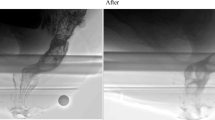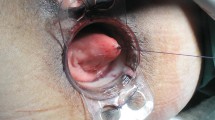Abstract
Introduction
Stapled transanal rectal resection (STARR) was developed to correct intussusception causing obstructed defecation. Some patients, however, do not profit from this operation as anticipated. We aimed to study the relationship between functional outcome and rectal morphology after STARR.
Methods
Fifteen consecutive female patients with median age of 64 years [interquartile range (IQR) 58–71 years] were studied before and after STARR. All patients had symptoms of obstructed defecation preoperatively. Pre- and postoperative workup consisted of standardized interview (including Wexner score) with physical examination including procto- and rectoscopy, anorectal manometry, and magnetic resonance (MR) defecography. Median follow up was 18 months (IQR 16–22 months).
Results
STARR was technically successful in all 15 patients without intra- or postoperative complications. Median (IQR) Wexner score of fecal incontinence was 0 (0–0) before and 3 (0–4.5) after surgery (p < 0.05). While all patients had repetitive incomplete defecation preoperatively, this symptom was present in seven patients postoperatively (p < 0.01). Third-degree intussusception was diagnosed during MR defecography in all patients preoperatively. After surgery, no patient had third-degree intussusception but one patient had first-degree and one patient had second-degree intussusception (p < 0.05). Size of rectocele was reduced from 2.9 cm (2.0–3.8 cm) to 0.8 cm (0.6–1.9 cm) (p < 0.05). Sphincter pressures were unchanged during anorectal manometry; however, first sensation during balloon distension in the rectum decreased from 50 ml (40–83 ml) before surgery to 30 ml (25–40 ml) after surgery (p < 0.05).
Conclusion
Stapled transanal rectal resection (STARR) achieved a high rate of morphological correction of intussusception; however, symptoms of obstructed defecation were not improved to the same extent, which warrants exploration in future studies.

Similar content being viewed by others
References
Andromanakos N, Skandalakis P, Troupis T, Filippou D (2006) Constipation of anorectal outlet obstruction: pathophysiology, evaluation and management. J Gastroenterol Hepatol 21:638–646
Tou S, Brown SR, Malik AI, Nelson RL (2008) Surgery for complete rectal prolapse in adults. Cochrane Database Syst Rev 4:CD001758
Marderstein EL, Delaney CP (2007) Surgical management of rectal prolapse. Nat Clin Pract Gastroenterol Hepatol 4:552–561
Longo A (2005) Obstructed defecation because of rectal pathologies. Novel surgical treatment: stapled transanal resection (STARR). In: Annual Cleveland Clinic Florida colorectal disease symposium, Fort Lauderdale, Florida, January 2005
Schwandner O, Fürst A, für das deutsche STARR Register Deutsches STARR Register (2007) Erste Ergebnisse der prospektiven, multizentrischen Beobachtungsstudie. Coloproctology 29:13–21
Corman ML, Carriero A, Hager T, Herold A, Jayne DG, Lehur PA, Lomanto D, Longo A, Mellgren AF, Nicholls J, Nyström PO, Senagore AJ, Stuto A, Wexner SD (2006) Consensus conference on the stapled transanal rectal resection (STARR) for disordered defaecation. Colorectal Dis 8:98–101
Bassi R, Rademacher J, Savoia A (2006) Rectovaginal fistula after STARR procedure complicated by haematoma of the posterior vaginal wall: report of a case. Tech Coloproctol 10:361–363
Pescatori M, Dodi G, Salafia C, Zbar AP (2005) Rectovaginal fistula after double-stapled transanal rectotomy (STARR) for obstructed defaecation. Int J Colorectal Dis 20:83–85
Arroyo A, González-Argenté FX, García-Domingo M, Espin-Basany E, De-la-Portilla F, Pérez-Vicente F, Calpena R (2008) Prospective multicentre clinical trial of stapled transanal rectal resection for obstructive defaecation syndrome. Br J Surg 95:1521–1527
Pescatori M, Zbar AP (2009) Reinterventions after complicated or failed STARR procedure. Int J Colorectal Dis 24:87–95
Schwandner O, Stuto A, Jayne D, Lenisa L, Pigot F, Tuech JJ, Scherer R, Nugent K, Corbisier F, Basany EE, Hetzer FH (2008) Decision-making algorithm for the STARR procedure in obstructed defecation syndrome: position statement of the group of STARR Pioneers. Surg Innov 15:105–109
De Nardi P, Bottini C, Faticanti Scucchi L, Palazzi A, Pescatori M (2007) Proctalgia in a patient with staples retained in the puborectalis muscle after STARR operation. Tech Coloproctol 11:353–356
Sciaudone G, Di Stazio C, Guadagni I, Selvaggi F (2008) Rectal diverticulum: a new complication of STARR procedure for obstructed defecation. Tech Coloproctol 12:61–63
Rockwood TH, Church JM, Fleshman JW, Kane RL, Mavrantonis C, Thorson AG, Wexner SD, Bliss D, Lowry AC (1999) Patient and surgeon ranking of the severity of symptoms associated with fecal incontinence: the fecal incontinence severity index. Dis Colon Rectum 42:1525–1532
Wexner SD, Baeten C, Bailey R, Bakka A, Belin B, Belliveau P, Berg E, Buie WD, Burnstein M, Christiansen J, Coller J, Galandiuk S, Lange J, Madoff R, Matzel KE, Påhlman L, Parc R, Reilly J, Seccia M, Thorson AG, Vernava AM 3rd (2002) Long-term efficacy of dynamic graciloplasty for fecal incontinence. Dis Colon Rectum 45:809–818
Evans RC, Kamm MA, Hinton JM, Lennard-Jones JE (1992) The normal range and a simple diagram for recording whole gut transit time. Int J Colorect Dis 7:15–17
Rentsch M, Paetzel C, Lenhart M, Feuerbach S, Jauch KW, Fürst A (2001) Dynamic magnetic resonance imaging defecography: a diagnostic alternative in the assessment of pelvic floor disorders in proctology. Dis Colon Rectum 44:999–1007
Lienemann A, Anthuber C, Baron A, Kohz P, Reiser M (1997) Dynamic MR colpocystorectography assessing pelvic-floor descent. Eur Radiol 7:1309–1317
Tiebert B, Lörcher U (2006) Radiologische Diagnostik. In: Lange J, Mölle B, Girona J (eds) Chirurgische Proktologie. Springer, Heidelberg, pp 134–156
Creve U, Hubens A (1979) The effect of Lord’s procedure on anal pressure. Dis Colon Rectum 22:483–485
Kreis ME, Jehle EC, Haug V, Manncke K, Buess GF, Becker HD, Starlinger MJ (1996) Functional results after transanal endoscopic microsurgery. Dis Colon Rectum 39:1116–1121
Arhan P, Faverdin C, Persoz B, Devroede G, Dubois F, Dornic C, Pellerin D (1976) Relationship between viscoelastic properties of the rectum and anal pressure in man. J Appl Physiol 41:677–682
Slim K, Mezoughi S, Launay-Savary MV, Tuech JJ, Michot F, Sielezneff I, Sastre B, Pigot F, Juguet F, Faucheron JL, Voirin D, Chipponi J (2008) Repair of rectocele using the stapled transanal rectal resection (STARR) technique: intermediate results from a multicenter French study. J Chir (Paris) 145:27–31
Freimanis MG, Wald A, Caruana B, Bauman DH (1991) Evacuation proctography in normal volunteers. Invest Radiol 26:581–585
Sailer M, Bönicke L, Petersen S (2007) Surgical options in the treatment of rectal prolapse: indications, techniques and results. Zentralbl Chir 132:350–357
Trompetto M, Clerico G, Realis Luc A, Marino F, Giani I, Ganio E (2006) Transanal Delorme procedure for treatment of rectocele associated with rectal intussusception. Tech Coloproctol 10:389
Zittel TT, Manncke K, Haug S, Schäfer JF, Kreis ME, Becker HD, Jehle EC (2000) Functional results after laparoscopic rectopexy for rectal prolapse. J Gastrointest Surg 4:632–641
Disclosures
Authors Reinhold A. Lang, Sonja Buhmann, Christine Lautenschlager, Mario H. Müller, Andreas Lienemann, Karl-Walter Jauch, and Martin E. Kreis have no conflicts of interest or financial ties to disclose.
Author information
Authors and Affiliations
Corresponding author
Rights and permissions
About this article
Cite this article
Lang, R.A., Buhmann, S., Lautenschlager, C. et al. Stapled transanal rectal resection for symptomatic intussusception: morphological and functional outcome. Surg Endosc 24, 1969–1975 (2010). https://doi.org/10.1007/s00464-010-0889-1
Received:
Accepted:
Published:
Issue Date:
DOI: https://doi.org/10.1007/s00464-010-0889-1




